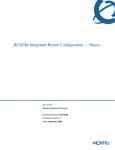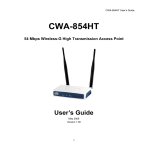Download ZyXEL Communications 1600 Network Router User Manual
Transcript
Prestige 652H/HW
ADSL Security/Wireless LAN Router
Compact Guide
Version 3.40
May 2003
Prestige 652H/HW
Table of Contents
1 Introducing the Prestige ................................................................................................................ 1
2 Hardware ........................................................................................................................................ 2
2.1 Rear Panel Connections............................................................................................................. 3
2.2 Inserting a PCMCIA Wireless LAN Card................................................................................. 4
2.3 The Front Panel LEDs............................................................................................................... 4
3 Setting Up Your Computer’s IP Address..................................................................................... 6
3.1 Windows 2000/NT/XP .............................................................................................................. 6
3.2 Checking/Updating Your Computer’s IP Address .................................................................... 7
3.3 Testing the Connection to the Prestige ...................................................................................... 8
4 Configuring Your Prestige............................................................................................................. 8
4.1 Accessing Your Prestige Via Web Configurator....................................................................... 8
4.2 Common Screen Command Buttons ....................................................................................... 10
4.3 Wizard Internet Access Configuration .................................................................................... 10
4.4 Test Your Internet Connection ................................................................................................ 14
5 Advanced Configuration.............................................................................................................. 14
5.1 Wireless LAN Setup................................................................................................................ 14
5.2 Wireless LAN Security Setup ................................................................................................. 16
5.3 Network Address Translation Overview ................................................................................. 18
5.4 Configuring SUA Server ......................................................................................................... 18
5.5 Firewall Overview................................................................................................................... 20
5.6 Enabling the Firewall .............................................................................................................. 21
5.7 Procedure for Configuring Firewall Rules .............................................................................. 22
5.8 Configuring Source and Destination Addresses ...................................................................... 25
5.9 VPN Overview ........................................................................................................................ 26
5.10 Summary Screen.................................................................................................................... 26
5.11 Configuring VPN Policies..................................................................................................... 28
5.12 Viewing SA Monitor ............................................................................................................. 33
5.13 UPnP Overview..................................................................................................................... 33
5.14 Configuring UPnP ................................................................................................................. 33
6 Troubleshooting............................................................................................................................ 35
1 Introducing the Prestige
The Prestige 652H/HW ADSL router is the ideal all-in-one device for small networks connecting to
the Internet via ADSL. Key features of the Prestige include firewall, VPN, wireless LAN, NAT,
Remote Management and UPnP. See your User’s Guide for more details on all Prestige features.
1
Prestige 652H/HW
You should have an Internet account already set up and have been given most of the following
information.
INTERNET ACCOUNT INFORMATION
Your device’s WAN IP Address (if given): __________________
DNS Server IP Address (if given): Primary __________________, Secondary _________________
Virtual Path Identifier (VPI): ____________
Virtual Channel Identifier (VCI): ____________
Multiplexing (VC-based or LLC-based):
VC
LLC
Encapsulation:
RFC 1483
ENET ENCAP
Ethernet Encapsulation Gateway IP Address: ____________________
PPPoA
User Name: ____________
PPPoE
Service Name: ____________
Password: ____________
User Name: ____________
Password: ____________
2 Hardware
2
Prestige 652H/HW
2.1 Rear Panel Connections
Figure 1 Prestige Hardware Connections
Table 1 Prestige Rear Panel Description
LABEL
DESCRIPTION
1.
DSL
Connect to a telephone jack using the included phone wire.
2.
LAN
1/DMZ-4
Connect to a computer/external hub using an Ethernet cable. Connect the DMZ port to servers
that you want visible to the outside world.
3.
POWER
Connect to a power source using the power adaptor for your region (see your User’s Guide).
After you’ve made the connections, connect the power adaptor to a power supply and push in the power button to
turn on the Prestige.
The PWR LED turns on. The SYS LED blinks while performing system testing and then turns steady on if the
testing is successful. A LAN LED turns on if a LAN port is properly connected.
3
Prestige 652H/HW
Table 1 Prestige Rear Panel Description
LABEL
DESCRIPTION
CON/AUX
switch
CON/AUX port
Only connect this port if you want to configure the Prestige using the SMT via console port or
set up a backup WAN connection; see your User’s Guide for details.
Set this switch to the “CON” side to use the CON/AUX port as a console port for local device
configuration and management. Connect the 9-pin male end of the console cable to the console
port of the Prestige and the other end to a serial port (COM1, COM2 or other COM port) on your
computer. Your computer should have a terminal emulation communications program (such as
HyperTerminal) set to VT100 terminal emulation, no parity, 8 data bits, 1 stop bit, no flow
control and 9600 bps port speed.
Set this switch to the “AUX” side to use the CON/AUX port as an auxiliary dial-up WAN
connection. Use the included CON/AUX converter, with the console cable to connect the
CON/AUX port to your modem or TA.
RESET
You only need to use this button if you’ve forgotten the Prestige’s password. It returns the
Prestige to the factory defaults (password is 1234, LAN IP address 192.168.1.1 etc.; see your
User’s Guide for details).
2.2 Inserting a PCMCIA Wireless LAN Card
Use a ZyAIR series wireless LAN PCMCIA card to add optional wireless LAN capabilities.
Step 1.
Turn off the Prestige.
Never insert or remove a wireless LAN card when the Prestige is turned on.
Step 2.
Locate the slot labeled Wireless LAN on the Prestige.
Step 3.
With its pin connector facing the slot and the LED side facing upwards, slide the ZyAIR
wireless LAN card into the slot.
Never force, bend or twist the wireless LAN card into the slot.
Step 4.
Turn on the Prestige. The WLAN LED should turn on.
2.3 The Front Panel LEDs
4
Prestige 652H/HW
Figure 2 Prestige Front Panel
Refer to the following table for more detailed LED descriptions.
Table 2 Front Panel LED Description
LED
PWR
SYS
LAN
1/DMZ-4
COLOR
Green
DESCRIPTION
On
The Prestige is receiving power.
Off
The Prestige is not receiving power.
On
The Prestige is functioning properly.
Blinking
The Prestige is restarting.
Off
The system is not ready or has malfunctioned.
Red
On
Power to the Prestige is too low.
Green
On
The Prestige has a successful 10Mb Ethernet connection.
Blinking
The Prestige is sending/receiving data.
Off
The Prestige does not have 10Mb Ethernet connection.
On
The Prestige has a successful 100Mb Ethernet connection.
Blinking
The Prestige is sending/receiving data.
Off
The Prestige does not have 100Mb Ethernet connection.
On
Wireless link is ready.
Off
Wireless link is not ready or has failed.
Blinking
The Prestige is sending/receiving data through the WLAN.
On
There has been an error with the wireless LAN PCMCIA card.
Green
Orange
WLAN
STATUS
Green
Red
5
Prestige 652H/HW
Table 2 Front Panel LED Description
LED
AUX
COLOR
Orange
Green
DSL
Green
ACT/PPP
Orange
Green
STATUS
DESCRIPTION
On
The CON/AUX port has a dial-up connection.
Off
The CON/AUX port does not have a dial-up connection.
On
The CON/AUX port has a console connection.
Off
The CON/AUX port does not have a console connection.
On
The Prestige is linked successfully to a DSLAM.
Blinking
The Prestige is initializing the DSL line.
Off
The DSL link is down.
On
The Prestige has a PPP (PPPoA or PPPoE) connection.
Blinking
The Prestige is sending/receiving PPPoA or PPPoE traffic.
Off
The system is ready, but is not sending/receiving data.
Blinking
The Prestige is sending/receiving non-PPP traffic.
3 Setting Up Your Computer’s IP Address
Skip this section if your computer is already set up to accept a dynamic IP
address. This is the default for most new computers.
The Prestige is already set up to assign your computer an IP address. Use this section to set up your
computer to receive an IP address or assign it a static IP address in the 192.168.1.2 to 192.168.1.254
range with a subnet mask of 255.255.255.0. This is necessary to ensure that your computer can
communicate with your Prestige.
Your computer must have an Ethernet card and TCP/IP installed. TCP/IP should already be installed
on computers using Windows NT/2000/XP, Macintosh OS 7 and later operating systems.
3.1 Windows 2000/NT/XP
1.
In Windows XP, click start, Control Panel. In Windows 2000/NT, click Start, Settings, Control Panel.
2.
In Windows XP, click Network Connections.
In Windows 2000/NT, click Network and Dial-up Connections.
3.
Right-click Local Area Connection and then click Properties.
4.
Select Internet Protocol (TCP/IP) (under the General tab in Win XP) and click Properties.
6
Prestige 652H/HW
5.
The Internet Protocol TCP/IP Properties screen opens (the
General tab in Windows XP).
- To have your computer assigned a dynamic IP address, click
Obtain an IP address automatically.
If you know your DNS sever IP address(es), type them in the
Preferred DNS server and/or Alternate DNS server fields.
-To configure a static IP address, click Use the following IP
Address and fill in the IP address (choose one
from192.168.1.2 to 192.168.1.254), Subnet mask
(255.255.255.0), and Default gateway (192.168.1.1) fields.
Then enter your DNS server IP address(es) in the Preferred
DNS server and/or Alternate DNS server fields.
If you have more than two DNS servers, click Advanced, the
DNS tab and then configure them using Add.
6.
Click Advanced. Remove any previously installed gateways in
the IP Settings tab and click OK to go back to the Internet
Protocol TCP/IP Properties screen.
7.
Click OK to close the Internet Protocol (TCP/IP) Properties
window.
8.
Click OK to close the Local Area Connection Properties
window.
3.2 Checking/Updating Your Computer’s IP Address
1.
In the computer, click Start, (All) Programs, Accessories and then Command Prompt.
2.
In the Command Prompt window, type "ipconfig" and then press ENTER to verify that your computer’s IP
address is in the correct range (192.168.1.2 to 192.168.1.254) with subnet mask 255.255.255.0. This is
necessary in order to communicate with the Prestige.
7
Prestige 652H/HW
Refer to your User’s Guide for detailed IP address configuration for other Windows and Macintosh
computer operating systems.
3.3 Testing the Connection to the Prestige
1.
Click Start, (All) Programs, Accessories and then Command Prompt.
2.
In the Command Prompt window, type "ping” followed by a space and the IP address of the Prestige
(192.168.1.1 is the default).
3.
Press ENTER and the following screen displays.
C:\>ping 192.168.1.1
Pinging 192.168.1.1 with 32 bytes of data:
Reply
Reply
Reply
Reply
from
from
from
from
192.168.1.1:
192.168.1.1:
192.168.1.1:
192.168.1.1:
bytes=32
bytes=32
bytes=32
bytes=32
time=10ms
time<10ms
time<10ms
time<10ms
TTL=254
TTL=254
TTL=254
TTL=254
Ping statistics for 192.168.1.1:
Packets: Sent = 4, Received = 4, Lost = 0 (0% loss),
Approximate round trip times in milli-seconds:
Minimum = 0ms, Maximum = 10ms, Average = 2ms
Your computer can now communicate with the Prestige using the LAN port.
4 Configuring Your Prestige
This Compact Guide shows you how to use the web configurator only. See
your User’s Guide for background information on all Prestige features and
SMT (System Management Terminal) configuration.
4.1 Accessing Your Prestige Via Web Configurator
Step 1.
Launch your web browser. Enter “192.168.1.1” as the web site address.
Web site address.
Figure 3 Entering Prestige LAN IP Address in Internet Explorer
Step 2.
An Enter Network Password window displays. Enter the user name (“admin” is the
default), password (“1234” is the default) and click OK.
8
Prestige 652H/HW
Default user name.
Figure 4 Web Configurator: Password Screen
Step 3.
You should now see the web configurator SITE MAP screen.
Click Wizard Setup to begin a series of screens to configure your Prestige for the first
time.
Click a link under Advanced Setup to configure advanced Prestige features.
Click a link under Maintenance to see Prestige performance statistics, upload firmware
and back up, restore or upload a configuration file.
Click Logout in the navigation panel when you have finished a Prestige management
session.
WIZARD
Navigation panel
Logout
Figure 5 Web Configurator: SITE MAP Screen
9
Prestige 652H/HW
The Prestige automatically logs you out if it is left idle for five minutes;
press ENTER to log back in again.
4.2 Common Screen Command Buttons
The following table shows common command buttons found on many web configurator screens.
Back
Click Back to return to the previous screen.
Apply
Click Apply to save your changes back to the Prestige.
Reset/Cancel
Click Reset or Cancel to begin configuring this screen afresh.
4.3 Wizard Internet Access Configuration
Use the Wizard Setup screens to configure your system for Internet access settings and fill in the
fields with the information in the Internet Account Information table. Your ISP may have already
configured some of the fields in the wizard screens for you.
Step 1.
In the SITE MAP screen click Wizard Setup to display the first wizard screen.
From the Mode drop-down list box, select Routing
(default) if your ISP allows multiple computers to
share an Internet account. Otherwise select Bridge.
Select the encapsulation type your ISP uses from the
Encapsulation drop-down list box. Choices vary
depending on what you select in the Mode field.
Select the multiplexing method used by your ISP from
the Multiplex drop-down list box.
Enter the correct Virtual Path Identifier (VPI) and
Virtual Channel Identifier (VCI) numbers supplied by
your ISP in the VPI and VCI fields. These fields may
already be configured.
Click Next.
Figure 6 Wizard Screen 1
Step 2.
The second wizard screen varies depending on what mode and encapsulation type you
use. All screens shown are with routing mode. Configure the fields and click Next to
continue.
10
Prestige 652H/HW
If your ISP provides the name of your
PPPoE service provider, enter it in the
Service Name field.
Enter the user name and password exactly
as your ISP assigned them.
Select Obtain an IP Address
Automatically if you have a dynamic IP
address; otherwise select Static IP Address
and type your ISP assigned IP address in
the text box below.
Select Connect on Demand when you don't
want the connection up all the time and
specify an idle time-out period (in seconds)
in the Max. Idle Timeout field.
Select Nailed-Up Connection when you
want your connection up all the time. The
Prestige will try to bring up the connection
automatically if it is disconnected.
Figure 7 Internet Connection with PPPoE
From the Network Address Translation drop-down list box, select SUA Only, Full Feature or None. Refer to
the Network Address Translation section for more information.
Enter the IP address given by your ISP in
the IP Address field.
The IP Address field is
not available for bridge
mode.
Refer to Figure 7 for description of the
Network Address Translation field.
Figure 8 Internet Connection with RFC 1483
11
Prestige 652H/HW
In the ENET ENCAP Gateway field, enter
the gateway IP address given by your ISP.
Refer to Figure 7 for other field descriptions.
Figure 9 Internet Connection with ENET ENCAP
Refer to Figure 7 for field descriptions.
The IP Address and
Network Address
Translation fields are not
available for bridge
mode.
Figure 10 Internet Connection with PPPoA
Step 3.
Verify the settings in the screen shown next. To change the LAN information on the
Prestige, click Change LAN Configurations. Otherwise click Save Settings to save the
configuration and skip to step 5.
12
Prestige 652H/HW
Figure 11 Wizard Screen 3
Step 4.
If you want to change your Prestige LAN settings, click Change LAN Configuration to
display the screen as shown next.
Enter the IP address of your Prestige in dotted decimal
notation in the LAN IP Address field. For example,
192.168.1.1 (factory default).
If you change the Prestige’s
LAN IP address, you must use
the new IP address if you want
to access the web configurator
again.
Enter a subnet mask in dotted decimal notation in the
LAN Subnet Mask field.
From the DHCP Server drop-down list box, select On
to allow your Prestige to assign IP addresses, an IP
default gateway and DNS servers to computer systems
that support the DHCP client. Select Off to disable
DHCP server.
When DHCP server is used, set the following items:
Figure 12 Wizard: LAN Configuration
Specify the first of the contiguous addresses in the IP address pool in the Client IP Pool Starting Address field.
Specify the size or count of the IP address pool in the Size of Client IP Pool field.
Enter the IP address(es) of the DNS server(s) in the Primary DNS Server and/or Secondary DNS Server fields.
13
Prestige 652H/HW
Step 5.
The Prestige automatically tests the connection to the computer(s) connected to the LAN
ports. To test the connection from the Prestige to the ISP, click Start Diagnose.
Otherwise click Return to Main Menu to go back to the Site Map screen.
Figure 13 Wizard Screen 4
4.4 Test Your Internet Connection
Launch your web browser and navigate to www.zyxel.com. Internet access is just the beginning.
Refer to the User’s Guide for more detailed information on the complete range of Prestige features.
If you cannot access the Internet, open the web configurator again to confirm that the Internet
settings you configured in the Wizard Setup are correct.
5 Advanced Configuration
This section shows how to configure some of the advanced features of the Prestige.
5.1 Wireless LAN Setup
A wireless LAN (WLAN) provides a flexible data communications system that you can use to
access various services (the Internet, email, printer services, etc.) on the wired network without
additional expensive network cabling infrastructure. In effect, a wireless LAN environment provides
you the freedom to stay connected to the wired network while moving in the coverage area.
The WLAN screens are only available when a WLAN card is installed.
To configure wireless settings, click Advanced Setup, Wireless and then click Wireless.
14
Prestige 652H/HW
Figure 14 Wireless LAN: Wireless
The following table describes the fields in this screen.
Table 3 Wireless LAN: Wireless
LABEL
DESCRIPTION
ESSID
(Extended Service Set IDentity) The ESSID is a unique name to identify the Prestige in the
wireless LAN. Wireless clients associating to an Access Point (the Prestige) must have the same
ESSID. Enter a descriptive name (up to 32 printable 7-bit ASCII characters).
Hide ESSID
Select Yes to hide the ESSID so a wireless client cannot obtain the ESSID through passive
scanning.
Select No to make the ESSID visible so a wireless client can obtain the ESSID through passive
scanning.
Channel ID
The range of radio frequencies used by IEEE 802.11b wireless devices is called a channel. Set
the operating frequency/channel depending on your particular region.
Select a channel from the drop-down list box. Adjacent APs with overlapping coverage areas
should use different channels to reduce crosstalk. Crosstalk occurs when the radio signals from
access points overlap and interfere with one another degrading performance.
15
Prestige 652H/HW
Table 3 Wireless LAN: Wireless
LABEL
RTS/CTS
Threshold
DESCRIPTION
Select this option to enable the RTS (Request To Send)/CTS (Clear To Send) threshold to
minimize collisions. Enter a value between 0 and 2432. The default is 2432.
Request To Send is the threshold (number of bytes) for enabling the RTS/CTS handshake. Data
with its frame size larger than this value will perform the RTS/CTS handshake. Setting this
attribute to be larger than the maximum MSDU (MAC Service Data Unit) size turns off the
RTS/CTS handshake.
Fragmentation
Threshold
Fragmentation Threshold is the maximum data fragment size that can be sent.
WEP
Encryption
WEP (Wired Equivalent Privacy) encrypts data frames before transmitting them over the
wireless network.
Select Disable allows all wireless computers to communicate with the access points without any
data encryption.
Select 64-bit WEP or 128-bit WEP and then configure the keys in the fields provided to activate
data encryption.
Key 1 to Key 4
The WEP keys are used to encrypt data. Both the Prestige and the wireless clients must use the
same WEP key for data transmission.
If you chose 64-bit WEP, then enter any 5 characters (ASCII string) or 10 hexadecimal
characters ("0-9", "A-F").
If you chose 128-bit WEP, then enter 13 characters (ASCII string) or 26 hexadecimal characters
("0-9", "A-F").
Select only one key to be activated at any one time.
The wireless clients and Prestige must use the same ESSID, channel ID and
WEP encryption key (if WEP is enabled) for wireless communication.
5.2 Wireless LAN Security Setup
For added security, set your Prestige to check the MAC address of the wireless client device against
a list of allowed or denied MAC addresses.
To set up the MAC address list for wireless LAN, click Advanced Setup in the navigation panel,
Wireless and then click the MAC Filter link.
16
Prestige 652H/HW
Figure 15 Wireless LAN: MAC Address Filter
The following table describes the fields in this screen.
Table 4 Wireless LAN: MAC Address Filter
LABEL
Active
DESCRIPTION
Select Yes from the drop down list box to enable MAC address filtering.
17
Prestige 652H/HW
Table 4 Wireless LAN: MAC Address Filter
LABEL
DESCRIPTION
Define the filter action for the list of MAC addresses in the MAC Address table.
Select Deny Association to block access to the router, MAC addresses not listed will be allowed
to access the router
Action
Select Allow Association to permit access to the router, MAC addresses not listed will be
denied access to the router.
MAC Address
Enter the list of MAC addresses in this table.
5.3 Network Address Translation Overview
NAT (Network Address Translation - NAT, RFC 1631) is the translation of the IP address of a host
in a packet. For example, the source address of an outgoing packet, used within one network is
changed to a different IP address known within another network.
If you have a single public IP address then select SUA Only in the NAT-Mode screen (see Figure
16). If you have multiple public IP addresses then you may use full feature mapping types (see the
User’s Guide for more details).
NAT supports five types of IP/port mapping. They are:
1.
One-to-One: One-to-one mode maps one local IP address to one global IP address. Note
that port numbers do not change for One-to-one NAT mapping type.
2.
Many-to-One: Many-to-One mode maps multiple local IP addresses to one global IP
address.
3.
Many-to-Many Overload: Many-to-Many Overload mode maps multiple local IP
addresses to shared global IP addresses.
4.
Many-to-Many No Overload: Many-to-Many No Overload mode maps each local IP
address to unique global IP addresses.
5.
Server: This type allows you to specify inside servers of different services behind the NAT
to be accessible to the outside world.
5.4 Configuring SUA Server
An SUA server set is a list of inside (behind NAT on the LAN) servers, for example, web or FTP,
that you can make visible to the outside world even though SUA makes your whole inside network
appear as a single computer to the outside world.
18
Prestige 652H/HW
Step 1.
From the main screen click Advanced Setup and then NAT to open the NAT-Mode
screen. Select SUA Only.
Figure 16 NAT: Mode
Step 2.
Click Edit Details.
Figure 17 SUA/NAT Server
The following table describes the fields in this screen.
19
Prestige 652H/HW
Table 5 SUA/NAT Server
LABEL
DESCRIPTION
Start Port
No.
Type a port number in this field. To forward only one port, type the port number again in the
End Port field. To forward a series of ports, type the start port number here and the end port
number in the End Port field.
End Port
No.
Type a port number in this field. To forward only one port, type the port number in the Start
Port field above and then type it again in this field. To forward a series of ports, type the last
port number in a series that begins with the port number in the Start Port field above.
IP Address
Enter the inside IP address of the server here.
5.5 Firewall Overview
The Prestige firewall is a stateful inspection firewall and is designed to protect against Denial of
Service attacks when activated. The Prestige’s purpose is to allow a private Local Area Network
(LAN) to be securely connected to the Internet. The Prestige can be used to prevent theft,
destruction and modification of data, as well as log events, which may be important to the security
of your network. The Prestige also has packet-filtering capabilities.
When activated, the firewall allows all traffic to the Internet that originates from the LAN, and
blocks all traffic to the LAN that originates from the Internet. In other words the Prestige will:
Allow all sessions originating from the LAN to the WAN
Deny all sessions originating from the WAN to the LAN
LAN-to-WAN rules are local network to Internet firewall rules. The default is to forward all traffic
from your local network to the Internet.
The following figure illustrates a Prestige firewall application.
20
Prestige 652H/HW
Figure 18 Prestige Firewall Application
5.6 Enabling the Firewall
From the main screen, click Advanced Setup, Firewall and then Config to open the Configuration
screen. Enable (or activate) the firewall by selecting the Enable Firewall check box as seen in the
following screen.
Figure 19 Enabling the Firewall
21
Prestige 652H/HW
5.7 Procedure for Configuring Firewall Rules
From the main screen, click Advanced Setup, Firewall and then Rule Summary (for either local
network to Internet rules or Internet to local network rules) to open the Summary screen. The
following table describes the fields in this screen.
Table 6 Summary Screen
LABEL
DESCRIPTION
The default action
for packets not
matching following
rules
Should packets that do not match the following rules be blocked or forwarded? Make your
choice from the drop down list box. Note that “block” means the firewall silently discards
the packet.
Default Permit Log
Click this check box to log all matched rules in the ACL default set.
The following read-only fields summarize the rules you have created that apply to traffic traveling in the selected
packet direction. The firewall rules that you configure (summarized below) take priority over the general firewall
action settings above.
No.
This is your firewall rule number. The ordering of your rules is important as rules are
applied in turn. The Move field below allows you to reorder your rules.
22
Prestige 652H/HW
Table 6 Summary Screen
LABEL
DESCRIPTION
Source IP
This drop-down list box displays the source addresses or ranges of addresses to which
this firewall rule applies. Please note that a blank source or destination address is
equivalent to Any.
Destination IP
This drop-down list box displays the destination addresses or ranges of addresses to
which this firewall rule applies. Please note that a blank source or destination address is
equivalent to Any.
Service
This drop-down list box displays the services to which this firewall rule applies. Please
note that a blank service type is equivalent to Any.
Action
This is the specified action for that rule, either Block or Forward. Note that Block means
the firewall silently discards the packet.
Log
This field shows you if a log is created for packets that match the rule (Match), don't
match the rule (Not Match), both (Both) or no log is created (None).
Rules Reorder
You may reorder your rules using this function. Select the rule you want to move. The
ordering of your rules is important as rules are applied in turn.
To Rule Number
Select the number you want to move the rule to.
Move
Click Move to move the rule.
Follow these directions to create a new rule.
Step 1.
In the Summary screen, click a rule’s index number. The Edit Rule screen opens.
Step 2.
In the Available Services text box, select the services you want. Configure customized
ports for services not predefined by the Prestige by clicking the Add or Edit buttons
under Custom Port. For a comprehensive list of port numbers and services, visit the
IANA (Internet Assigned Number Authority) web site.
Step 3.
Configure the Source Address and Destination Address for the rule.
23
Prestige 652H/HW
Figure 20 Creating/Editing A Firewall Rule
The following table describes the fields in this screen.
Table 7 Creating/Editing A Firewall Rule
LABEL
DESCRIPTION
Source Address
Click SrcAdd to add a new address, SrcEdit to edit an existing one or SrcDelete to
delete one. Please see the next section for more information on adding and editing source
addresses.
Destination
Address
Click DestAdd to add a new address, DestEdit to edit an existing one or DestDelete to
delete one. Please see the following section on adding and editing destination addresses.
Services
Highlight a service from the Available Services box on the left, then click >> to add it to
the Selected Services box on the right. To remove a service, highlight it in the Selected
Services box on the right, then click <<.
Available/
Selected Services
24
Prestige 652H/HW
Table 7 Creating/Editing A Firewall Rule
LABEL
DESCRIPTION
Edit Available
Service
Click this button to go to the list of available custom services.
Action for Matched
Packets
Should packets that match this rule be blocked or forwarded? Make your choice from the
drop down list box. Note that Block means the firewall silently discards the packet.
Log
This field determines if a log is created for packets that match the rule, don’t match the
rule, both or no log is created.
Alert
Check the Alert check box to determine that this rule generates an alert when the rule is
matched.
Delete
Click Delete to remove this rule.
5.8 Configuring Source and Destination Addresses
To add a new source or destination address, click SrcAdd or DestAdd from the previous screen. To
edit an existing source or destination address, select it from the box and click SrcEdit or DestEdit
from the previous screen. Either action displays the following screen.
Figure 21 Adding/Editing Source and Destination Addresses
The following table describes the fields in this screen.
Table 8 Adding/Editing Source and Destination Addresses
LABEL
DESCRIPTION
Address Type
Do you want your rule to apply to packets with a particular (single) IP address, a range of
IP addresses (e.g., 192.168.1.10 to 192.169.1.50), a subnet or any IP address? Select an
option from the drop down list box
Start IP Address
Enter the single IP address or the starting IP address in a range here.
25
Prestige 652H/HW
Table 8 Adding/Editing Source and Destination Addresses
LABEL
DESCRIPTION
End IP Address
Enter the ending IP address in a range here.
Subnet Mask
Enter the subnet mask here, if applicable.
5.9 VPN Overview
A VPN (Virtual Private Network) provides secure communications between sites without the
expense of leased site-to-site lines. A secure VPN is a combination of tunneling, encryption,
authentication, access control and auditing technologies/services used to transport traffic over the
Internet or any insecure network that uses the TCP/IP protocol suite for communication.
The following figure provides an example of a VPN application.
Figure 22 VPN Application
5.10 Summary Screen
Local and remote IP addresses must be static.
26
Prestige 652H/HW
From the main screen, click Advanced Setup, VPN, and Setup to open the Summary screen. This
is a read-only menu of your IPSec rules (tunnels).
Figure 23 VPN Summary
The following table describes the fields in this screen.
Table 9 VPN Summary
LABEL
DESCRIPTION
No.
The VPN policy index number
Name
This field displays the identification name for this VPN policy.
Active
This field displays whether the VPN policy is active or not. A Yes signifies that this VPN
policy is active. No signifies that this VPN policy is not active.
Local Address
This is the IP address(es) of computer(s) on your local network behind your Prestige.
The same (static) IP address is displayed twice when the Local Address Type field in
the Configure-IKE (or Manual) screen is configured to Single Address.
The beginning and ending (static) IP addresses, in a range of computers are displayed
when the Local Address Type field in the Configure-IKE (or Manual) screen is
configured to Range Address.
A (static) IP address and a subnet mask are displayed when the Local Address Type
field in the Configure-IKE (or Manual) screen is configured to Subnet Address.
27
Prestige 652H/HW
Table 9 VPN Summary
LABEL
Remote Address
DESCRIPTION
This is the IP address(es) of computer(s) on the remote network behind the remote
IPSec router.
This field displays N/A when the Secure Gateway IP Address field displays 0.0.0.0. In
this case only the remote IPSec router can initiate the VPN.
The same (static) IP address is displayed twice when the Remote Address Type field
in the Configure-IKE (or Manual) screen is configured to Single Address.
The beginning and ending (static) IP addresses, in a range of computers are displayed
when the Remote Address Type field in the Configure-IKE (or Manual) screen is
configured to Range Address.
A (static) IP address and a subnet mask are displayed when the Remote Address
Type field in the Configure-IKE (or Manual) screen is configured to Subnet Address.
Encap
This field displays Tunnel or Transport mode (Tunnel is the default selection).
IPSec Algorithm
This field displays the security protocols used for an SA.
Both AH and ESP increase Prestige processing requirements and communications
latency (delay).
Secure Gateway
IP
This is the static WAN IP address or URL of the remote IPSec router. This field displays
0.0.0.0 when you configure the Secure Gateway IP Address field in the ConfigureIKE screen to 0.0.0.0.
5.11 Configuring VPN Policies
Click an IPSec rule’s index number to open the VPN IKE screen where you can configure the
IPSec rule.
28
Prestige 652H/HW
Figure 24 VPN IKE
The following table describes the fields in this screen.
29
Prestige 652H/HW
Table 10 VPN IKE
LABEL
DESCRIPTION
Active
Select this check box to activate this VPN tunnel. This option determines whether a
VPN rule is applied before a packet leaves the firewall.
Keep Alive
Select either Yes or No from the drop-down list box.
Select Yes to have the Prestige automatically re-initiate the SA after the SA lifetime
times out, even if there is no traffic. The remote IPSec router must also have keep alive
enabled in order for this feature to work.
Name
Type up to 32 characters to identify this VPN policy. You may use any character,
including spaces, but the Prestige drops trailing spaces.
IPSec Key Mode
Select IKE or Manual from the drop-down list box. IKE provides more protection so it is
generally recommended. Manual is a useful option for troubleshooting.
Negotiation Mode
Select Main or Aggressive from the drop-down list box. Multiple SAs connecting
through a secure gateway must have the same negotiation mode.
Local
Local IP addresses must be static and correspond to the remote IPSec router's
configured remote IP addresses.
Two active SAs can have the same local or remote IP address, but not both. You can
configure multiple SAs between the same local and remote IP addresses, as long as
only one is active at any time.
Local Address
Type
Use the drop-down menu to choose Single, Range, or Subnet. Select Single for a
single IP address. Select Range for a specific range of IP addresses. Select Subnet to
specify IP addresses on a network by their subnet mask.
IP Address Start
When the Address Type field is configured to Single, enter a (static) IP address on the
LAN behind your Prestige. When the Address Type field is configured to Range, enter
the beginning (static) IP address, in a range of computers on your LAN behind your
Prestige. When the Address Type field is configured to Subnet, this is a (static) IP
address on the LAN behind your Prestige.
End/ Subnet Mask
When the Address Type field is configured to Single, this field is N/A. When the
Address Type field is configured to Range, enter the end (static) IP address, in a
range of computers on the LAN behind your Prestige. When the Address Type field is
configured to Subnet, this is a subnet mask on the LAN behind your Prestige.
Remote
Remote IP addresses must be static and correspond to the remote IPSec router's
configured local IP addresses. The remote fields do not apply when the Secure
Gateway IP Address field is configured to 0.0.0.0. In this case only the remote IPSec
router can initiate the VPN.
Two active SAs cannot have the local and remote IP address(es) both the same. Two
active SAs can have the same local or remote IP address, but not both. You can
configure multiple SAs between the same local and remote IP addresses, as long as
only one is active at any time.
30
Prestige 652H/HW
Table 10 VPN IKE
LABEL
DESCRIPTION
Remote Address
Type
Use the drop-down menu to choose Single, Range, or Subnet. Select Single with a
single IP address. Select Range for a specific range of IP addresses. Select Subnet to
specify IP addresses on a network by their subnet mask.
IP Address Start
When the Address Type field is configured to Single, enter a (static) IP address on the
network behind the remote IPSec router. When the Address Type field is configured to
Range, enter the beginning (static) IP address, in a range of computers on the network
behind the remote IPSec router. When the Address Type field is configured to Subnet,
enter a (static) IP address on the network behind the remote IPSec router.
End / Subnet Mask
When the Address Type field is configured to Single, this field is N/A. When the
Address Type field is configured to Range, enter the end (static) IP address, in a
range of computers on the network behind the remote IPSec router. When the Address
Type field is configured to Subnet, enter a subnet mask on the network behind the
remote IPSec router.
Local ID Type
Select IP to identify this Prestige by its IP address.
Select DNS to identify this Prestige by a domain name.
Select E-mail to identify this Prestige by an e-mail address.
Content
When you select IP in the Local ID Type field, type the IP address of your computer or
leave the field blank to have the Prestige automatically use its own IP address.
When you select DNS in the Local ID Type field, type a domain name (up to 31
characters) by which to identify this Prestige.
When you select E-mail in the Local ID Type field, type an e-mail address (up to 31
characters) by which to identify this Prestige.
The domain name or e-mail address that you use in the Content field is used for
identification purposes only and does not need to be a real domain name or e-mail
address.
My IP Address
Enter the WAN IP address of your Prestige. The Prestige uses its current WAN IP
address (static or dynamic) in setting up the VPN tunnel if you leave this field as
0.0.0.0.
The VPN tunnel has to be rebuilt if this IP address changes.
Peer ID Type
Select IP to identify the remote IPSec router by its IP address.
Select DNS to identify the remote IPSec router by a domain name.
Select E-mail to identify the remote IPSec router by an e-mail address.
31
Prestige 652H/HW
Table 10 VPN IKE
LABEL
Content
DESCRIPTION
When you select IP in the Peer ID Type field, type the IP address of the computer with
which you will make the VPN connection or leave the field blank to have the Prestige
automatically use the address in the Secure Gateway IP Address field.
When you select DNS in the Peer ID Type field, type a domain name (up to 31
characters) by which to identify the remote IPSec router.
When you select E-mail in the Peer ID Type field, type an e-mail address (up to 31
characters) by which to identify the remote IPSec router.
The domain name or e-mail address that you use in the Content field is used for
identification purposes only and does not need to be a real domain name or e-mail
address. The domain name also does not have to match the remote router's IP address
or what you configure in the Secure Gateway IP Address field below.
Secure Gateway
IP Address
Type the WAN IP address or the URL (up to 31 characters) of the IPSec router with
which you're making the VPN connection. Set this field to 0.0.0.0 if the remote IPSec
router has a dynamic WAN IP address (the Key Management field must be set to IKE).
Encapsulation
Mode
Select Tunnel mode or Transport mode from the drop-down list box.
VPN Protocol
Select ESP if you want to use ESP (Encapsulation Security Payload). The ESP protocol
(RFC 2406) provides encryption as well as some of the services offered by AH. If you
select ESP here, you must select options from the Encryption Algorithm and
Authentication Algorithm fields (described below).
Select AH if you want to use AH (Authentication Header Protocol). The AH protocol
(RFC 2402) was designed for integrity, authentication, sequence integrity (replay
resistance), and non-repudiation but not for confidentiality, for which the ESP was
designed. If you select AH here, you must select options from the Authentication
Algorithm field (described below).
Pre-shared Key
VPN Setup
Type your pre-shared key in this field. A pre-shared key identifies a communicating
party during a phase 1 IKE negotiation. It is called "pre-shared" because you have to
share it with another party before you can communicate with them over a secure
connection. Multiple SAs connecting through a secure gateway must have the same
pre-shared key.
Select DES, 3DES or NULL from the drop-down list box.
When DES is used for data communications, both sender and receiver must know the
same secret key, which can be used to encrypt and decrypt the message or to generate
and verify a message authentication code. The DES encryption algorithm uses a 56-bit
key. Triple DES (3DES) is a variation on DES that uses a 168-bit key. As a result,
3DES is more secure than DES. It also requires more processing power, resulting in
increased latency and decreased throughput. Select NULL to set up a tunnel without
encryption. When you select NULL, you do not enter an encryption key.
32
Prestige 652H/HW
Table 10 VPN IKE
LABEL
DESCRIPTION
Authentication
Algorithm
Select SHA1 or MD5 from the drop-down list box. MD5 (Message Digest 5) and SHA1
(Secure Hash Algorithm) are hash algorithms used to authenticate packet data. The
SHA1 algorithm is generally considered stronger than MD5, but is slower. Select MD5
for minimal security and SHA-1 for maximum security.
Advanced
Click Advanced to configure more detailed settings of your IKE key management.
Delete
Click Delete to remove this rule.
5.12 Viewing SA Monitor
A Security Association (SA) is the group of security settings related to a specific VPN tunnel. This
screen displays active VPN connections. Use Refresh to display active VPN connections. This
screen is read-only.
From the main screen, click Advanced Setup, and Monitor to view Security Associations.
When there is outbound traffic but no inbound traffic, the SA times out
automatically after two minutes. A tunnel with no outbound or inbound
traffic is "idle" and does not timeout until the SA lifetime period expires.
5.13 UPnP Overview
Universal Plug and Play (UPnP) is a distributed, open networking standard that uses TCP/IP for
simple peer-to-peer network connectivity between devices. A UPnP device can dynamically join a
network, obtain an IP address, convey its capabilities and learn about other devices on the network.
In turn, a device can leave a network smoothly and automatically when it is no longer in use.
All UPnP-enabled devices may communicate freely with each other without additional
configuration. Disable UPnP if this is not your intention.
Windows ME and Windows XP support UPnP. See the Microsoft website for information about
other Microsoft operating systems.
Make sure you apply Microsoft’s UPnP security patch before enabling the
UPnP feature. Refer to the Microsoft website.
5.14 Configuring UPnP
Click Advanced Setup and then UPnP to open the UPnP screen.
33
Prestige 652H/HW
Figure 25 UPnP
The following table describes the fields in this screen.
Table 11 UPnP
FIELD
DESCRIPTION
Enable the Universal Plug
and Play (UPnP) Service
Select this checkbox to activate UPnP. Be aware that anyone could use a UPnP
application to open the web configurator's login screen without entering the
Prestige's IP address (although you must still enter the password to access the
web configurator).
Allow users to make
configuration changes
through UPnP
Select this check box to allow UPnP-enabled applications to automatically
configure the Prestige so that they can communicate through the Prestige, for
example by using NAT Traversal, UPnP applications automatically reserve a
NAT forwarding port in order to communicate with another UPnP enabled
device; this eliminates the need to manually configure port forwarding for the
UPnP enabled application.
Allow UPnP to pass through
Firewall
Select this check box to allow traffic from UPnP-enabled applications to bypass
the firewall.
Clear this check box to have the firewall block all UPnP application packets (for
example, MSN packets).
34
Prestige 652H/HW
6 Troubleshooting
Table 12 Troubleshooting
PROBLEM
CORRECTIVE ACTION
None of the LEDs turn
on when you turn on
the Prestige.
Make sure that you have the correct power adapter connected to the Prestige and
plugged in to an appropriate power source. Check all cable connections.
Cannot access the
Prestige from the LAN.
Check the cable connection between the Prestige and your computer or hub. Refer to
the Rear Panel Connections section for details.
If the LEDs still do not turn on, you may have a hardware problem. In this case, you
should contact your local vendor.
Ping the Prestige from a LAN computer. Make sure your computer Ethernet adapter is
installed and functioning properly.
Cannot ping any
computer on the LAN.
If the LAN LEDs are all off, check the cable connections between the Prestige and your
LAN computers.
Verify that the IP address, subnet mask of the Prestige and the LAN computers are in
the same IP address range.
Cannot ping any
computer on the
WLAN
Make sure the wireless card is properly inserted in the Prestige and the WLAN LED is
on.
Make sure the wireless card on the wireless client is working properly.
Check that both the Prestige and wireless client(s) are using the same ESSID, channel
and WEP keys (if WEP encryption is activated).
Cannot get a WAN IP
address from the ISP.
Cannot access the
Internet.
Check your Encapsulation, Multiplex and VPI/VCI settings (refer to section 4.3).
You need a user name and password if you’re using PPPoE or PPPoA encapsulation.
Make sure that you have entered the correct Service Name (PPPoE encapsulation
only), User Name and Password (the username and password are case sensitive).
Refer to section 4.3 for more information.
Verify the Internet connection settings in the WAN screen.
Make sure you entered the correct user name and password.
For wireless clients, check that both the Prestige and wireless client(s) are using the
same ESSID, channel and WEP keys (if WEP encryption is activated).
35


















































